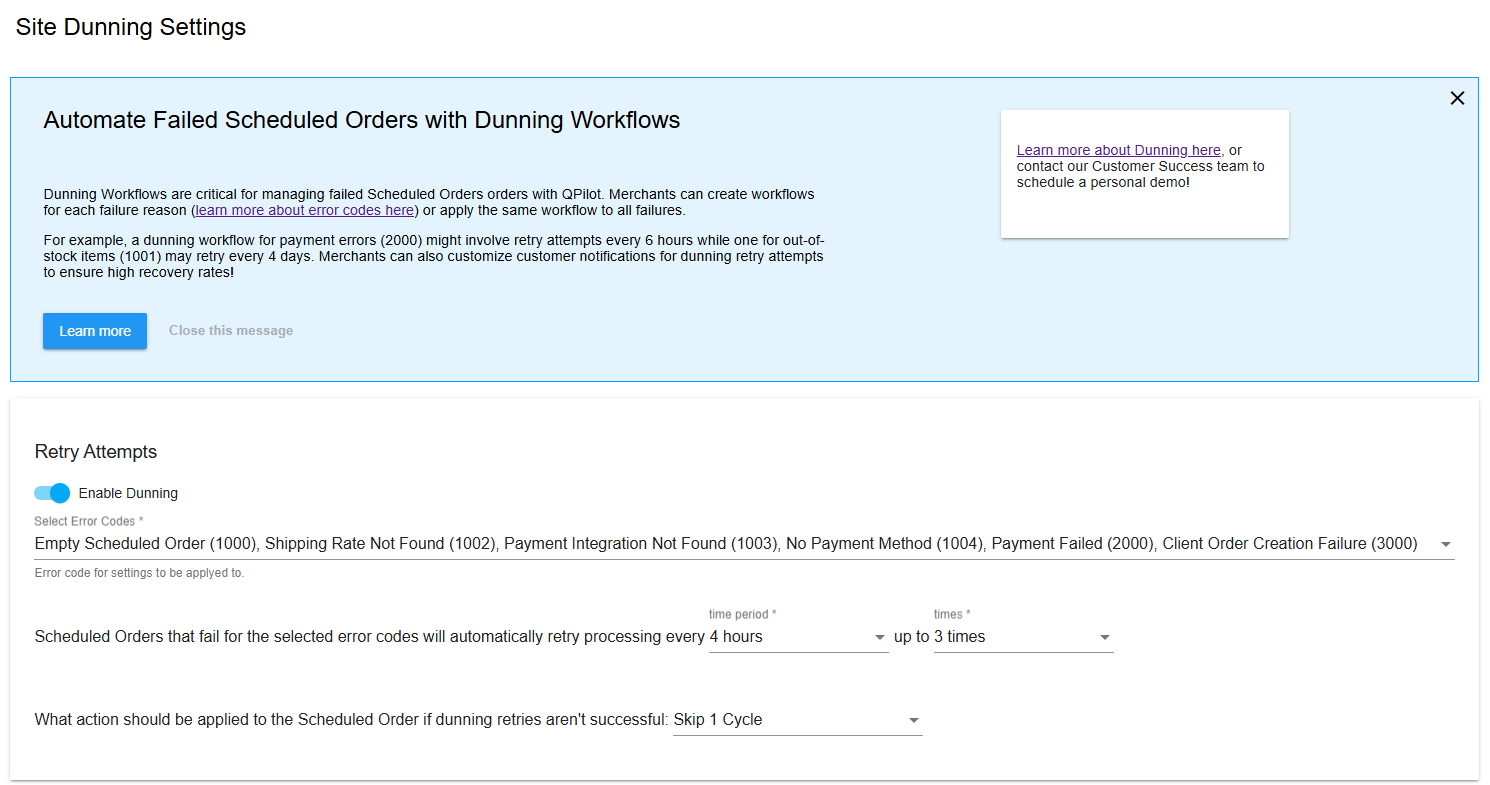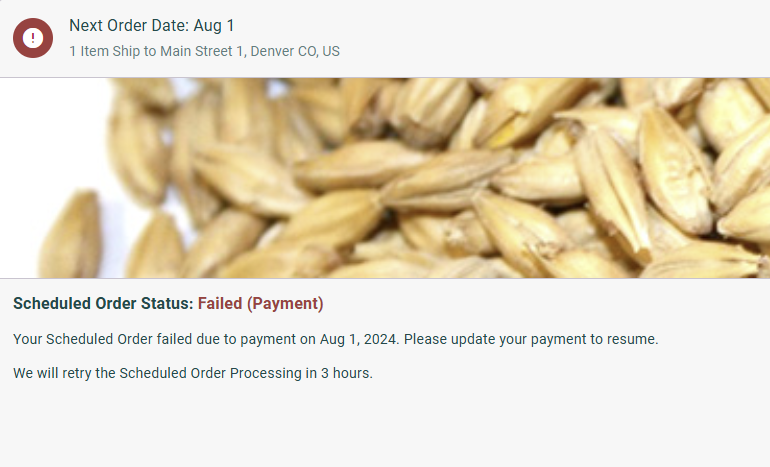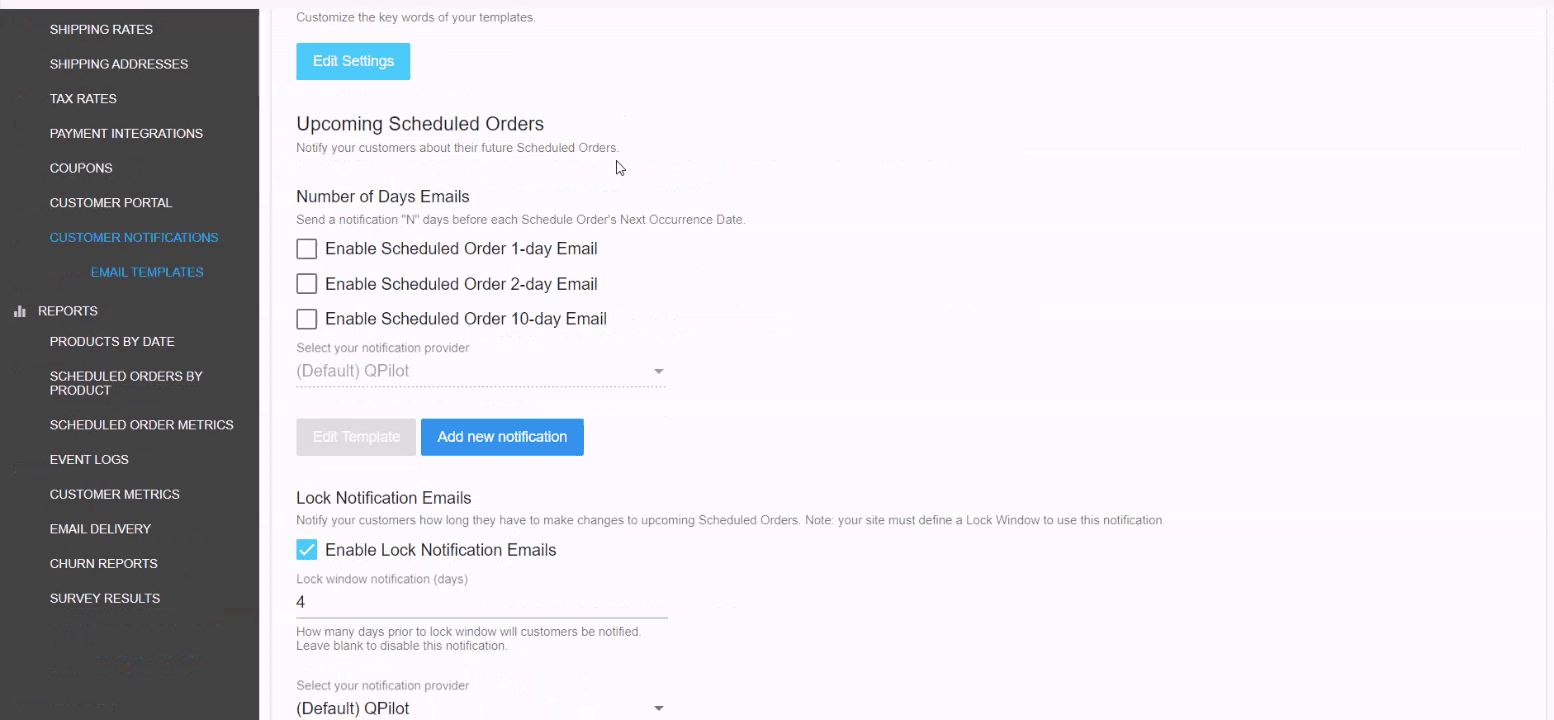Dunning Workflows
Dunning workflows enable you to automatically update failed Scheduled Orders based on a certain cadence and error reason and are critical for managing failed Scheduled Orders orders within QPilot.

Dunning Workflow Dashboard
Merchants can create workflows for a select few failure reasons (learn more about error codes here) or apply the same workflow to all failures. Merchants can also customize customer notifications for dunning retry attempts to ensure high recovery rates!
Table of Contents:
Note:
Dunning workflows are different than inactive Scheduled Order management MAP workflows. Both can be enabled at the same time but should not overlap. We recommend that you have both enabled but ensure there are at least several days in between the end of your dunning flow and when the MAP will be triggered.
How to Set Up a New Dunning Workflow
You can setup dunning in 4 quick steps! Learn more below.
- Create your dunning workflow
- Select what errors will trigger the dunning workflow
- Select the retry cadence & action
- Edit your dunning messaging for Customer Notifications
Creating a Dunning Workflow

You can toggle your dunning workflow to be enabled or disabled, edit your retry cadence, actions, and dunning messages anytime in QPilot Merchant Center > Dashboard >> Retain & Grow >> Dunning.
- Changes to enabled dunning workflows will affect all Scheduled Orders in dunning currently (along with those placed into a dunning status moving forward).
- Disabling an enabled workflow while Scheduled Orders are in dunning will automatically remove them from the dunning workflow (they will remain failed by default). However, if you re-enable dunning, they will pickup where they were in the dunning workflow.
What errors can you select?
You can select all error types except for Order Update Failures (3001 error) for dunning workflows (learn more here). We generally suggest ensuring you have at least selected the following errors, as these are the most likely to be recovered by dunning workflows:
- Payment Failures (2000 error)
- No Payment Methods (1004 error)
Retry Cadence
Retry cadences are an important part of your dunning flow. Deciding how often and long to retry a Scheduled Order can depend on your dunning model, product, and even the error code.
You can select the following cadences for retries, regardless of the error type:
- Time period: How often will processing be retried. A merchant can select every 1 hour to every 4 days.
- Times: How many times will processing be retried at the time period selected. A merchant can select 1-5 times.
By default, the selection is every 4 hours for 3 times, which means the Scheduled Order will be retried every 4 hours for 3 attempts.
We generally recommend changing your settings based on which and how many errors are included:
- Generally, payment-related failures (2000 and 1004 errors) are safe to retry more often. For example, if a card has insufficient funds or is declined, the chances of the card being successfully charged within a couple of days are high.
- If you are including several errors in your dunning flow (such as 3 or more error codes), then it may be better to space out your retries more or shorten the dunning process. For example, retry every 12 hours for 8 days or every 4 hours for 2 days.
No Items To Ship Failures
If Scheduled Orders fail frequently for 1001 No Item To Ship errors on your site, we recommend excluding this error from your dunning workflow unless you often restock quickly (within 2 weeks).
If you do experience 1001 errors and don't restock within 2 weeks often, it may be confusing for your customer to have their Scheduled Order retried multiple times while the item is out of stock.
Failed Dunning
What happens if a Scheduled Order isn't recovered from the dunning process and is still failed after the retry cadence is completed? Merchants can choose from 3 actions when a Scheduled Order fails dunning:
- Nothing - The Scheduled Order will remain failed (with no further retries) until the status is updated by the merchant, customer, or another workflow (such as a MAP).
- Move to Cancelled - The Scheduled Order will automatically be placed into a Deleted status. While it will no longer be accessible by the customer, a merchant can still access and recover (update/reactivate) the Scheduled Order.
- (Recommended) Skip - The Scheduled Order will be automatically updated to an Active status with the following Next Occurrence Date (as if it had processed successfully) so it's retried at a future date automatically.
Failed Cycles
Because the dunning process retries Scheduled Orders multiple times, you may notice an increased number of failed processing cycles reflected in your Dashboard reports. If you have any questions or concerns about an increased number of failures, please don't hesitate to reach out to our Customer Success Team!
Customer Experience
When a Scheduled Order is placed into a dunning workflow, your customer will see that their Scheduled Order is "Failed", along with a message including when their next retry is expected.
If a customer updates a Scheduled Order so it's no longer "Failed" by either successfully retrying it themselves (in which case the Scheduled Order would become Active with a future Next Occurrence Date) or by resuming/deleting it then it will automatically be taken out of the dunning workflow.

Example of how the Scheduled Order will look to a customer when in a dunning status.
Dunning Messages
Dunning messages are set in your dunning workflow and can be edited anytime. However, you must add these dunning messages to your failed Customer Notifications as well (see below). Note: You can use "{{ScheduledOrder}}" if you have localized your sites term for "Scheduled Order". For example, some merchants prefer the term "Subscription".

Example of Dunning Messages
Dunning Messages to Set
- First Retry Attempt: This is the dunning message that will be displayed in your customer notifications when it first fails and is included in a dunning workflow. For example: If there is a total of 4 retries, then this message will be sent before any of those retries.
- Example: If no changes are made, we will automatically retry processing your {{ScheduledOrder}} in {{NextDunningHours}} hours.
- Result: If no changes are made, we will automatically retry your Scheduled Order in 8 hours.
- Retry Attempts: This dunning message will be displayed during retry attempts (after the first attempt and until the last attempt). For example, if there is a total of 3 retries, then this message will be sent 2 times.
- Example: If no changes are made, we will automatically retry processing your {{ScheduledOrder}} in {{NextDunningHours}} hours for {{RetryCountLeft}} more attempts.
- Result: If no changes are made, we will automatically retry your Scheduled Order in 8 hours for 3 more attempts.
- Final Retry Attempt: This is the dunning message that will be displayed in your customer notifications when it's the final retry attempt in the dunning process. For example, if there is a total of 4 retries then this will be sent one the 4th retry.
- Example: If no changes are made, we will automatically {{DunningAction}} your {{Scheduled Order}}.
- Result: If no changes are made, we will automatically skip your Scheduled Order.
- Action Applied: This is the dunning message that will be displayed in your customer notifications when it fails to be recovered during the dunning process. For example, if there is a total of 4 retries then this will be sent if the Scheduled Order failed to process and after all 4 retries.
- Example: Your {{ScheduledOrder}} was {{DunningAction}} automatically.
- Result: Your Scheduled Order was Skipped automatically.
What if a Scheduled Order is processed successfully or updated so it's no longer failed?
If a Scheduled Order is processed successfully or updated manually so it's not longer failed, it will be taken out of the dunning process automatically.
What Dynamic Fields Can You Use
These dynamic fields can be added for customizing the dunning notifications. Dynamic fields can only be used in the dunning messages below.
- {{NextDunningHours}} - How many hours until the Scheduled Order will be retried again unless dunning is cancelled.
- {{DunningHours}} - How often will Scheduled Orders in the dunning process be retried for (example: every 3 hours).
- {{DunningDays}} - How many days will the Scheduled Order be retried (example: for 10 days)
- {{RetryCountDone}} - How many times the Scheduled Order has been retried in the current dunning process.
- {{RetryCountLeft}} - How many more times the Scheduled Order will be retried unless dunning is cancelled.
- {{RetryCount}} - The total number of times a Scheduled Order can be retried in the dunning process.
- {{DunningAction}} - What action is taken when a Scheduled Order finishes the dunning process but has not been processed successfully. For example, it may be Skipped or Deleted.
Customer Notifications
If you have enabled your dunning workflow, it's important to update your Customer Notifications to include dunning messages.
This is a quick and easy process, as outlined below! QPilot will automatically update which dunning message is sent (see above) in the customer notification based on that specific Scheduled Order. If the Scheduled Order is failed but not placed into a dunning status, QPilot will automatically hide the dunning message in the customer notification.
Setup Dunning Messages in Customer Notifications
- Go to QPilot Merchant Center > Dashboard >> Customer Notifications.
- Edit your failed Scheduled Order Notifications templates.
- Add the dynamic field "{{ScheduledOrder.DunningMessage}}" to your notifications "Before Content Text" section (or as desired).
- Reminder: This message will change dynamically based on A) whether a Scheduled Order is in dunning or not and B) what stage of dunning the Scheduled Order is in.
- Save your updated template & repeat this process for all enabled failed Scheduled Order notifications.

Example of Adding Your Dunning Message to Notifications
Managing Scheduled Orders in Dunning
As a merchant, you can quickly view a Scheduled Order's dunning status and history to assist customers in recovery. You can take a Scheduled Order out of dunning anytime by updating the status out of Failed or manually processing it. Your customers can also update a Scheduled Order in dunning at any time by editing their status (such as processing the Scheduled Order manually/etc.).
-
As a merchant, you can filter for Scheduled Orders in dunning by toggling on the filter for "Failed" in QPilot Merchant Center > Dashboard >> Scheduled Orders and then reviewing the column "Status". Any in dunning will be marked as "Dunning".

Example of Scheduled Orders in Dunning as a Merchant
-
As a merchant, you can view dunning history by selecting "View Event Logs" from a specific Scheduled Order action menu in QPilot Merchant Center > Dashboard >> Scheduled Orders.

Example of Dunning Related Event Logs
Updated 10 months ago
